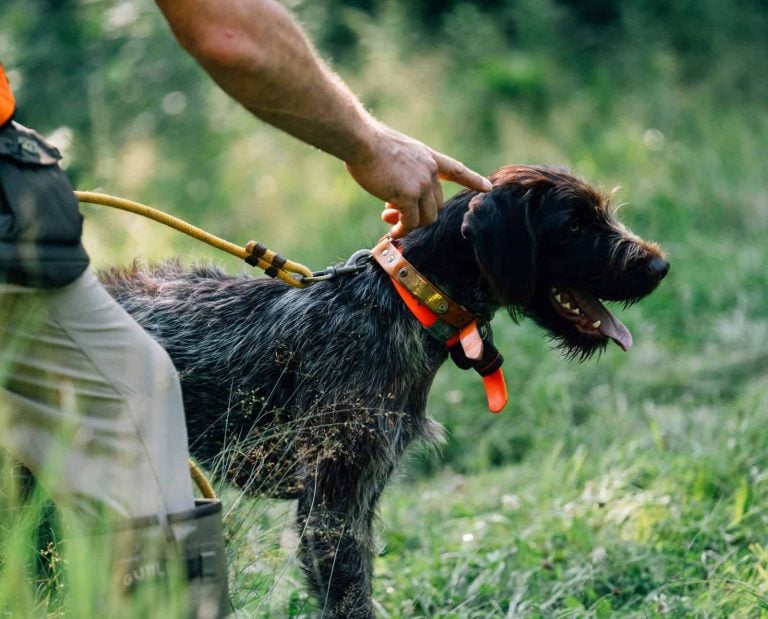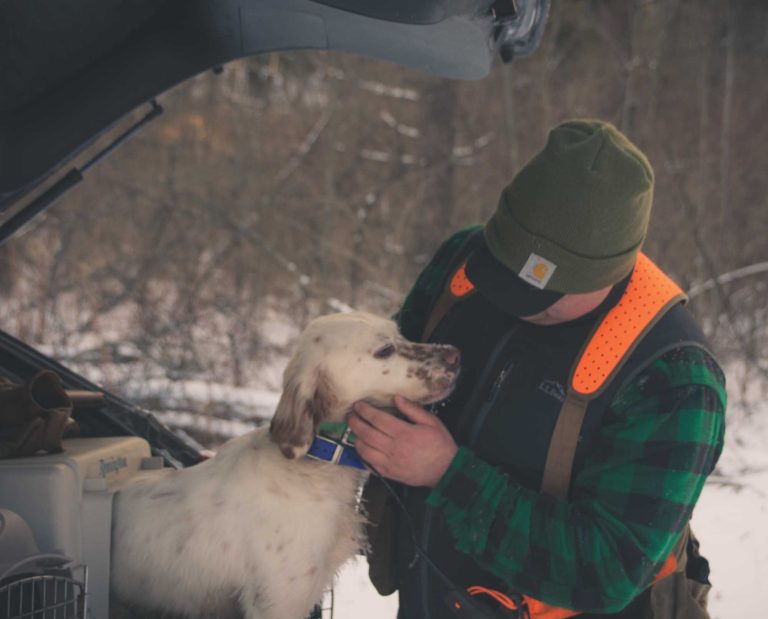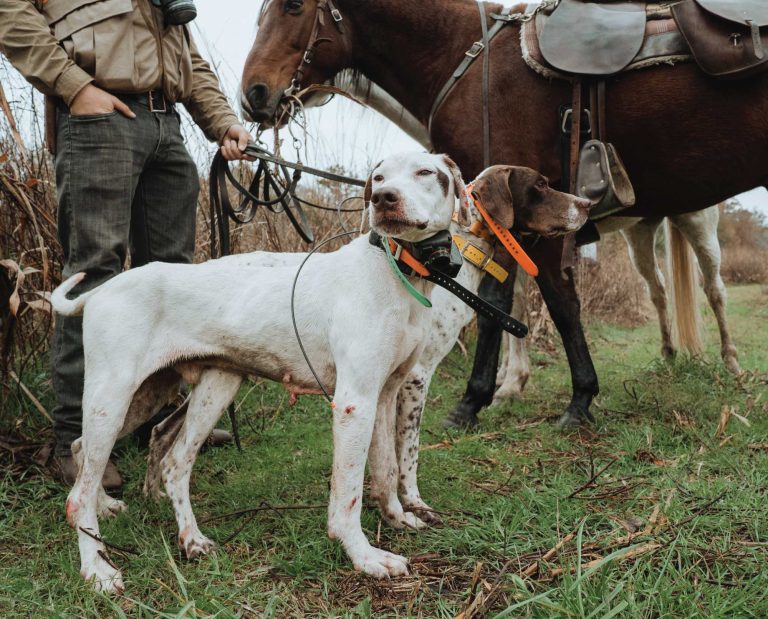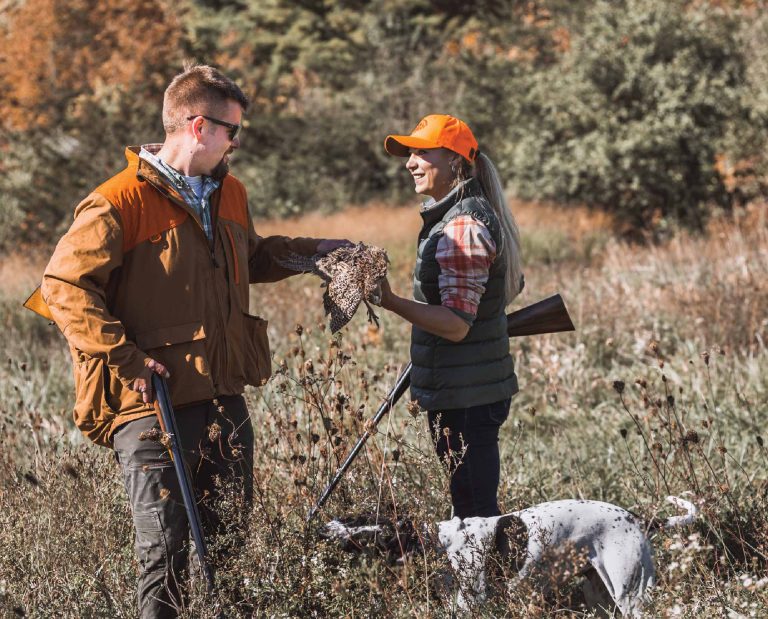Bird Dog Tracking with a Bell, Beeper, and GPS?
Bird dog tracking with a bell, beeper, and GPS may be more practical than you think
Imagine yourself making your way through a favorite cover on a crisp October morning with a trusted hunting buddy. As you fight your way through the brush, you are compelled forward by the jingle-jangle tone of your favorite bird dog tracking bell strapped to your favorite dog. As the sound of the dog bell grows fainter, you duck under a fallen spruce tree.
When you emerge on the other side, the bell has stopped. You turn to your hunting partner for confirmation. He nods and shrugs his shoulders. Your thought process is interrupted by the vibration of your GPS receiver. You look down and read those precious words, “Copper On Point.” As you level the receiver in your hand, the needle gives you a proper heading and tells you there is 120 yards between you and the dog. You motion to your partner and you both head in that direction.
After what feels like minutes, the dog is still not in sight. You decide to pause and take another reading. The dog is 25 yards to your 2 o’clock. You were close, but slightly off course. At this point, you are in the critical range. The dog is still on point and the bird has held. Hopefully. Rather than speak out to your hunting partner and expose the bird to the sound of a human voice, you again motion a slight correction in your course.
Just as you begin making progress, you tap the “locate” button on the dog’s beeper collar. A clear, audible tone rings out briefly and then all is quiet again. However now, you and your partner have a specific location and a focused plan of attack without further communication or the continual beeping of the collar. The shape of the dog takes form. Rigid, head-high, and not 10-yards from a tangle of brush. Now it’s up to you to finish the job. Now the only sound is the flushing of wings and the echo of shotgun blasts.
I just described a near perfect situation in which all three of the most common bird dog tracking tools were utilized in locating the dog and approaching the point. Not every scenario will require the use of all three tools. Yet I can assure you that when you do need all three, you will be grateful you have them.
I could argue that having all three bird dog tracking tools on my dog’s neck completes the ideal bird dog tracking system for hunting grouse and American woodcock in thick northern covers. Without getting into too much detail, I will explain what I like about each one and what makes it an essential component of my bird dog tracking set-up.
The bell: The classic bird dog tracking device
The bell has been used since the upland hunters of old for tracking our four-legged companions through briars and bramble, aspen and alders. Not only does the bell provide a classic and pleasant sound during the course of the hunt, it also gives the hunter valuable feedback with respect to the pace and cadence of the dog’s hunt. Not only are you getting a sense of your dog’s location, you’re learning how he is hunting. Or not hunting and making game. For those reasons, I consider the bell to be essential in bird dog tracking.
So what is lacking in the bell? When the dog stops moving, the bell stops ringing. This is fine when conditions are ideal and you are paying close attention. All the hunter has to do is start in that direction. With any luck, you’ll encounter the dog on point. But what if you don’t? What if you were distracted when the bell stopped ringing?What if the dog hunts out of bell range?
In the old days this was simply part of the game. Dogs were lost and found—or sometimes not. Fortunately, today’s upland hunters need not settle for only the sound of the bell to locate their dogs. This is where the beeper bird dog tracking system comes in.
Beeper collars: When thick cover is common place
The next best thing for upland hunters turned out to be the electronic tone-emitting collar or “beeper.” I won’t provide a history lesson on the beeper, as I don’t have much experience with the older kinds. What I will say is that beeper technology has improved greatly since then. The technology today is far superior to early iterations of this device.
The beeper collar I use is a standalone unit with remote control. This enables me to select the mode of the beeper with the remote strapped to my vest. This is regardless of where the dog is, as long as he is in range. Beepers today often come with three main modes: hunt and point, point only, and locate.
Hunt and point will sound the beeper at a constant interval of 5-7 seconds while the dog is running. When the dog goes on point, the interval shortens to 2-3 seconds. Point-only mode keeps the beeper silent when the dog is running and switches to the 2-3 second interval when the dog goes on point. Locate mode keeps the beeper silent, unless I press the “locate” button from my remote. I typically use the “locate” mode and only when it’s necessary.
GPS: The new age of bird dog tracking
Finally, we arrive at the GPS tracking collar. Many upland hunters believed that the GPS collar would spell the end of the bell and beeper as we knew them. That hasn’t happened. The GPS tracking collars of today accurately track the location of your dog and report that location back to you every 2-3 seconds via the handheld receiver you carry. For many forms of upland hunting, the GPS is perfect. It allows hunters to keep track of their dog, get notified when it goes on point, and be directed to the dog on point. All of this without ever a sound emitting from the dog’s neck! You might be thinking, why does a hunter need anything more than a GPS?
There are times in the grouse woods that the GPS gets you close. But no matter how close you get, it still can’t show you exactly where the dog is. In that critical moment when the dog is near, you have to assume that the bird is in shooting range. Without a visual on the dog, I’m left with very little idea how to approach the situation safely and effectively. This is the exact moment where the locate feature on my dog’s beeper collar becomes the final and essential piece of the puzzle.
With the quick tap of a button, I have an eyes-free, near pin-point location on my dog. Often times when my eyes focus in on the origin of the sound, I will quickly spot the dog where I couldn’t before. If I’m lucky, I now have the exact location of my dog, possibly an idea of how he is oriented, and where I might be able to expect a flush.
I know this probably sounds like a lot of ifs, ands, or buts. And it is. However I have encountered this scenario more than enough times to give me the peace of mind that utilizing a GPS, bell, and beeper is simply the best setup for bird dog tracking.
Conclusion
There are a couple of considerations to running all three bird dog tracking tools on your dog. The first has to be the cost of the set-up. Training and hunting collars are not cheap. As a result, the thought of purchasing two of them plus a bell is probably enough to scare most people off. That being said, most of us are not afraid to spend money on our bird dogs. I have tried to show you the value of owning every piece of the puzzle.
I quantify my bird hunting experience by the enjoyment factor. Am I making the most out of every minute I have to spend in the woods? I won’t hesitate to spend money on something (within reason) that will increase the safety or overall experience of the hunt. Plus, it’s safe to say that most bird dog owners probably already own one or two pieces of this system. It might just be a matter of acquiring the last one.
In a perfect world, we would only need to purchase one collar and strap a bell on our dog to make this system work. Yet so far, the manufacturers have refused to design a GPS collar that works in combination with a beeper. I can’t really blame them, since grouse hunting is a small niche. But could there not be a beeper add-on option for the track-and-train collar? I’m sure that the first manufacturer to incorporate a beeper into their GPS collar would be met with a significant demand from upland hunters who realize the potential of such a collar-system.
Until then, I will continue to run my Frankenstein bird dog tracking set-up. And I will continue to enjoy the complete functionality and versatility of it all.










